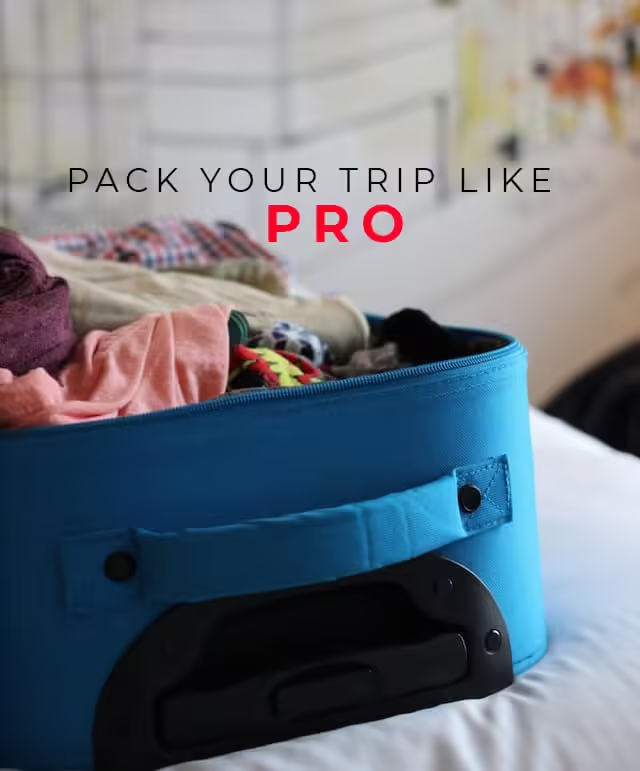Packing Like a Pro in 7 essential techniques
If you’re someone who dreads the thought of packing for a trip, you’re not alone. The task of fitting everything you need into a limited amount of space can be overwhelming. But fear not, because with some expert tips and a little planning, you can learn to pack for a trip like a pro. Whether you’re going on a short weekend getaway or embarking on a long-term adventure, we’ve got you covered. In this article, we’ll share practical advice on how to pack efficiently and effectively, from choosing the right luggage to packing smart, so you can avoid the stress and hassle of overpacking or forgetting important items.
I . Make a list

Making a list is an essential step when it comes to packing like a pro.
Before you start putting anything into your suitcase or backpack, take the time to create a detailed packing list. Begin by considering the length of your trip and the activities you’ll be doing, and then list all the essential items you’ll need for each day.
When making your list, it’s a good idea to divide it into categories such as clothing, toiletries, electronics, and documents. This will help you stay organized and ensure that you don’t forget anything important.
As you pack, check off each item on your list to make sure you don’t miss anything. Having a list will also help you avoid overpacking, as you’ll have a clear idea of what you need and what you can leave behind.
By taking the time to make a comprehensive packing list, you’ll be able to pack efficiently and effectively for your next trip.
II . Choose the right luggage

Choosing the right luggage is crucial when it comes to packing for a trip like a pro. The type of luggage you choose will depend on the length and nature of your trip, as well as your personal preferences. The first thing to consider is the size of your luggage. If you’re only going away for a weekend, a small carry-on suitcase or backpack might be enough. For longer trips, a larger suitcase or duffel bag may be more appropriate.
Another important factor to consider is the material of your luggage. Hard-shell suitcases are more durable and offer better protection for your belongings, but they can be heavy and less flexible than soft-shell options. Soft-shell luggage, on the other hand, is lighter and more flexible, making it easier to fit into tight spaces. Additionally, some soft-shell options are made from water-resistant materials, which can be beneficial if you’re traveling to a rainy destination.
The type of wheels and handles on your luggage is also important. Four-wheel suitcases are more maneuverable and easier to roll around, while two-wheel options are more stable and easier to navigate over uneven surfaces. As for handles, telescoping handles are standard on most suitcases, but it’s worth checking the length and sturdiness of the handle to ensure it’s comfortable to use. Some luggage also comes with additional handles, which can make it easier to lift and carry. By considering all these factors and choosing the right luggage for your needs, you’ll be able to pack efficiently and travel with ease.
III . Pack versatile clothing
Packing versatile clothing is key to packing like a pro. The key to versatility is choosing items that can be mixed and matched to create multiple outfits. Start by selecting a color scheme that you can stick to for your entire trip. This will allow you to easily mix and match items and create a variety of outfits without having to pack too many clothes. Neutral colors such as black, white, and gray are great for creating a versatile wardrobe that can be dressed up or down depending on the occasion.
Another important factor to consider when packing versatile clothing is the material. Look for items that are made from lightweight, breathable fabrics that can be worn in different weather conditions. Clothing made from materials such as cotton or linen are great for warm weather destinations, while wool or synthetic fabrics are better for colder climates. Additionally, look for items that can be dressed up or down depending on the occasion, such as a pair of jeans that can be worn with a casual t-shirt during the day or dressed up with a blouse and heels at night.
IV . Use packing cubes

Packing cubes are a game-changer when it comes to packing for a trip like a pro. These small, lightweight bags come in a variety of sizes and can be used to organize your luggage and make packing and unpacking a breeze. By separating your clothing and accessories into different cubes, you’ll be able to easily find what you need without having to rummage through your entire suitcase.
One of the main benefits of using packing cubes is that they help to maximize space in your luggage. By compressing your clothing and accessories into smaller cubes, you’ll be able to fit more items into your suitcase without having to sacrifice organization. Additionally, packing cubes can help to prevent wrinkling, as they keep clothing items neatly folded and in place during transit.
Another benefit of using packing cubes is that they can be easily transferred between different pieces of luggage. For example, if you’re going on a multi-destination trip and need to switch from a backpack to a suitcase, you can simply move your packing cubes from one bag to the other. This not only saves time but also helps to maintain organization throughout your trip. By investing in a set of packing cubes, you’ll be able to pack efficiently and travel with ease.
V . Roll your clothing

Rolling your clothing is a simple but effective technique that can help you pack more efficiently and fit more items into your luggage. Rather than folding your clothing items, roll them tightly into compact cylinders. This not only saves space but also helps to prevent wrinkles, as the fabric is less likely to crease when it’s rolled.
When rolling your clothing, start with the heavier and bulkier items at the bottom of your suitcase or packing cube. This will help to create a stable base for the rest of your items and prevent them from shifting around during transit. Then, roll your clothing items tightly and place them in a vertical position in your suitcase or packing cube. This allows you to fit more items into your luggage while also keeping them organized and easy to access.
VI . Pack strategically (pack for a trip like a pro)
One useful tip for packing strategically is to use the empty spaces in your luggage. For example, you can stuff socks and underwear into shoes or use the space inside hats or purses to store smaller items. Another useful strategy is to wear your bulkiest or heaviest items, such as boots or a winter coat, during transit to free up space in your luggage. Additionally, consider using compression bags or packing cubes to maximize space and keep items organized.
Another key aspect of packing strategically is knowing what items to leave behind. Avoid packing items that you can easily purchase at your destination, such as toiletries or snacks, to save space in your luggage. Consider renting bulky equipment, such as skis or snorkeling gear, instead of bringing your own. Finally, consider packing versatile items that can serve multiple purposes, such as a lightweight scarf that can be used as a shawl or a beach cover-up. By packing strategically, you’ll be able to travel with ease and avoid the stress of overpacking or forgetting important items.
VII . Keep essentials in your carry-on
Keeping essential items in your carry-on bag can help ensure that you have everything you need in case your checked luggage gets lost or delayed. Here are two tips for keeping essentials in your carry-on:
Pack a change of clothes: If your checked luggage is lost or delayed, having a change of clothes in your carry-on can help you feel more comfortable and prepared. Pack a lightweight outfit that can easily be layered and mixed and matched with other clothing items in your luggage. This is especially important if you have a connecting flight or a long layover, as you may not have immediate access to your checked luggage.
Keep important documents and valuables with you: It’s always a good idea to keep your passport, travel documents, and any valuables (such as jewelry or electronics) with you in your carry-on bag. This ensures that they’re easily accessible and reduces the risk of loss or theft. Additionally, if you’re traveling with medication, make sure to pack it in your carry-on to ensure that you have access to it throughout your trip. Remember to check the TSA guidelines for packing liquids, medications, and other items to ensure that you comply with their regulations.
In conclusion, packing for a trip can be a daunting task, but with the right strategies, it can be a stress-free experience. By making a list, choosing the right luggage, packing versatile clothing, using packing cubes, rolling your clothing, packing strategically, and keeping essentials in your carry-on, you can pack like a pro and avoid the hassles of overpacking or forgetting important items. These simple tips and tricks can make all the difference in ensuring that you have a comfortable and enjoyable trip. With a little planning and organization, you can pack efficiently and effectively, leaving you with more time and energy to enjoy your travels. So, pack smart and travel with ease!













